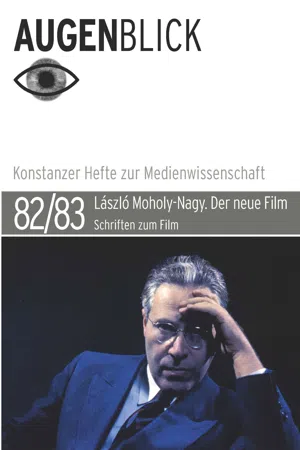
- 224 pages
- English
- PDF
- Available on iOS & Android
About this book
Der Band enthält eine Auswahl von László Moholy-Nagys Schriften zum FilmAus dem Inhalt: 1 «Produktion-Reproduktion» (1922)2 «Dynamik der Großstadt» (1924/25)3 «Das Simultan- oder Polykino» (1925)4 [Auszüge aus: ] Die Bühne im Bauhaus (1925)5 «Das Kinoplakat» (1925)6 «Film im Bauhaus. Eine Erwiderung von L. Moholy-Nagy» (1926)7 «geradlinigkeit des geistes – umwege der technik» (1927)8 [Auszug aus: ] Malerei, Fotografie, Film (1927)9 «Zum sprechenden Film» (1928)10 «Der Künstler gehört in die Industrie! Ein Gespräch mit Professor L. Moholy-Nagy, Dessau-Berlin» (1928)11 «Die Optik in Tonfilm» (1929)12 «Nie wieder Filmausschnitte!» (1929)13 Das Kind des Anderen / Sturm über Asien / Johanna von Orleans [Drei Filmbesprechungen (1929)]14 «Noch einmal die Elemente» (1929)15 «Das Problem des neuen Films: Los von der Malerei!» (1929)16 «Probleme des neuen Films» (1930–1936)17 «Lichtrequisit einer elektrischen Bühne» (1930)18 «Lichtspiel-Film» (1931)19 «Einleitung zum Vortrag ‹Malerei und Fotografie›» (1931/1932)20 «Die neuen Möglichkeiten des Films (Lichtspiel Schwarz-Weiss-Grau)» (1932)21 «Der Beste Filmeinfall» (1933)22 «Neue Filmexperimente» (1933)23 «Offener Brief an die Filmindustrie und an Alle, die Interesse an der Entwicklung des guten Films haben» (1934)24 «Tonfilm – Farbfilm, und dann?» (1935)25–27?Texte aus einem Sonderheft der Zeitschrift telehor (1936) über Moholy-Nagy25 «Brief an František Kalivoda» (1935)26 «Vom Pigment zum Licht» (1935)27 «huhn bleibt huhn. Ein film-scenario unter benützung eines motives aus «auguste bolte» von kurt schwitters» (1935)28 «About the Elements of Motion Picture» (1940)29 [Auszug aus: ] sehen in bewegung (1947)
Frequently asked questions
- Essential is ideal for learners and professionals who enjoy exploring a wide range of subjects. Access the Essential Library with 800,000+ trusted titles and best-sellers across business, personal growth, and the humanities. Includes unlimited reading time and Standard Read Aloud voice.
- Complete: Perfect for advanced learners and researchers needing full, unrestricted access. Unlock 1.4M+ books across hundreds of subjects, including academic and specialized titles. The Complete Plan also includes advanced features like Premium Read Aloud and Research Assistant.
Please note we cannot support devices running on iOS 13 and Android 7 or earlier. Learn more about using the app.
Information
Table of contents
- Inhalt
- Editorische Notiz
- 1 «Produktion – Reproduktion»
- 2 «Dynamik der Großstadt»
- 3 «Das Simultan- oder Polykino»
- 4 Die Bühne im Bauhaus (Auszüge)
- 5 «film im bauhaus. eine erwiderung von l. moholy-nagy, bauhaus-dessau»
- 6 «Das Kinoplakat»
- 7 «geradlinigkeit des geistes – umwege der technik»
- 8 Malerei Fotografie Film (Auszug)
- 9 «Zum sprechenden Film»
- 10 «Der Künstler gehört in die Industrie! Ein Gespräch mit Professor L. Moholy-Nagy, Dessau-Berlin»
- 11 «Die Optik im Tonfilm»
- 12 «Nie wieder Filmausschnitte!»
- 13 Das Kind des Anderen /Johanna von Orleans / Sturm über Asien [Drei Filmbesprechungen]
- 14 «Noch einmal die Elemente»
- 15 «Das Problem des neuen Films:Los von der Malerei!»
- 16 «Probleme des neuen Films»
- 17 «Lichtrequisit einer elektrischen Bühne»
- 18 «Lichtspiel-Film»
- 19 «einleitung zum vortrag ‹malerei und fotografie›. köln, dezember 1931»
- 20 «Die neuen Möglichkeiten des Films (Lichtspiel Schwarz-Weiss-Grau)»
- 21 «Der beste Filmeinfall»
- 22 «Neue Filmexperimente»
- 23 «Offener Brief an die Filmindustrie und an Alle, die Interesse an der Entwicklung des guten Films haben»
- 24 «Tonfilm, Farbfilm – und was kommt danach? (Hangosfilm–színesfilm, és azután?)»
- 25 «Brief an František Kalivoda»
- 26 «vom pigment zum licht»
- 27 «huhn bleibt huhn»
- 28 «About the Elements of Motion Picture»
- 29 sehen in bewegung (Auszug)
- 30 «Resümee eines Künstlers»
- Filmografie
- Impressum